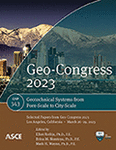Penetration Effect of Penetrator Geometry and Interface Friction on Rotational Penetration Resistance
Publication: Geo-Congress 2023
ABSTRACT
A previous study by the authors showed that the rotational movement of a cylindrical cone penetrator could significantly reduce penetration resistance. The effects of penetrator geometry and penetrator-particle interface friction are studied to shed light on the design of a self-burrowing robot in this study. The penetrator-granular media interactions were investigated at different scales by using the discrete element method. Generally, the penetration force on the cone increases with the penetration depth but decreases with the relative slip velocity (the ratio between the rotational velocity and the vertical velocity, vr/v). The penetration force on the cone increases in the sequence of square, decagon, and flat-end penetrators under the same conditions due to the cross section areas. Besides, the penetration force on the cone also increases with the interface friction. Force chain network and particle trajectory visualize the rotational effect at particle-scale with different penetrator geometries. Overall, the normalized penetration force on the cone decreases dramatically at first and then gradually with the increase of the relative slip velocity. The normalized penetration force on the cone for flat-end penetrator is higher than that for square and decagon penetrators under same relative slip velocity. The normalized penetration force on the cone decreases further with the increase of the interface friction under the same relative slip velocity.
Get full access to this article
View all available purchase options and get full access to this chapter.
REFERENCES
Abraham, Y., and R. Elbaum. 2013. “Hygroscopic movements in Geraniaceae: The structural variations that are responsible for coiling or bending.” New Phytologist, 199 (2): 584–594.
Arroyo, M., J. Butlanska, A. Gens, F. Calvetti, and M. Jamiolkowski. 2011. “Cone penetration tests in a virtual calibration chamber.” Géotechnique, 61 (6): 525–531.
Evangelista, D., S. Hotton, and J. Dumais. 2011. “The mechanics of explosive dispersal and self-burial in the seeds of the filaree, Erodium Cicutarium (Geraniaceae).” Journal of Experimental Biology, 214 (4): 521–529.
Gans, C. 1968. “Relative Success of Divergent Pathways in Amphisbaenian Specialization.” The American Naturalist, 102 (926): 345–362. The University of Chicago Press.
Hunt, O. M. 2021. Bio-Inspired Methods for Reduction of Penetration Resistance in Granular Materials. M.{{S}}. United States – California: University of California, Davis.
Jung, W., S. M. Choi, W. Kim, and H.-Y. Kim. 2017. “Reduction of granular drag inspired by self-burrowing rotary seeds.” Physics of Fluids, 29 (4): 041702.
Liu, C., X. Tang, H. Wei, P. Wang, and H. Zhao. 2020. “Model Tests of Jacked-Pile Penetration into Sand Using Transparent Soil and Incremental Particle Image Velocimetry.” KSCE Journal of Civil Engineering, 24 (4): 1128–1145.
Marvi, H., J. P. Cook, J. L. Streator, and D. L. Hu. 2016. “Snakes move their scales to increase friction.” Biotribology, 5: 52–60.
Sadeghi, A., A. Tonazzini, L. Popova, and B. Mazzolai. 2014. “A Novel Growing Device Inspired by Plant Root Soil Penetration Behaviors.” PLoS ONE, (J. Bongard, ed.), 9 (2): e90139.
Sheng, D., K. D. Eigenbrod, and P. Wriggers. 2005. “Finite element analysis of pile installation using large-slip frictional contact.” Computers and Geotechnics, 32 (1): 17–26.
Smilauer, V., et al. 2021. “Yade documentation.”.
Tang, Y., and J. Tao. 2022. “Multiscale analysis of rotational penetration in shallow dry sand and implications for self-burrowing robot design.” Acta Geotechnica.
Zhang, D., Y. Chen, Y. Ma, L. Guo, J. Sun, and J. Tong. 2016. “Earthworm epidermal mucus: Rheological behavior reveals drag-reducing characteristics in soil.” Soil and Tillage Research, 158: 57–66.
Information & Authors
Information
Published In
History
Published online: Mar 23, 2023
Authors
Metrics & Citations
Metrics
Citations
Download citation
If you have the appropriate software installed, you can download article citation data to the citation manager of your choice. Simply select your manager software from the list below and click Download.
